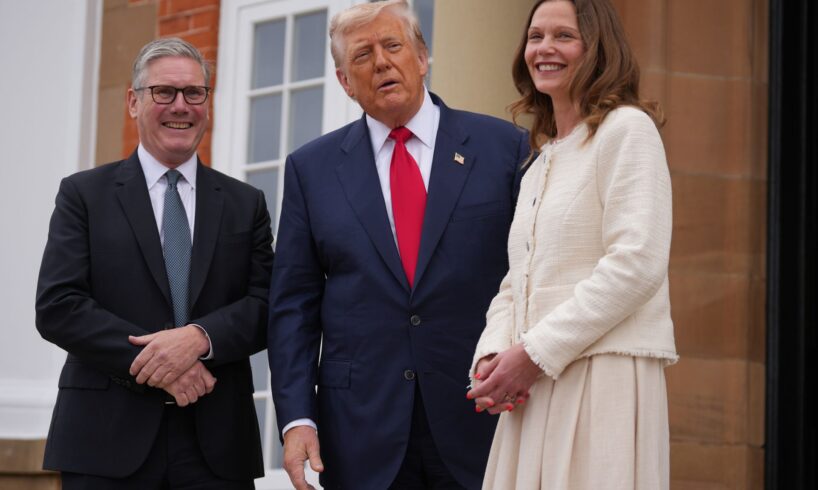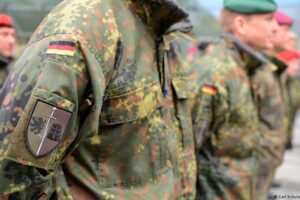
Key developments on July 28:
‘I already know the answer’ — Trump to shorten Ukraine deadline for Putin to 10–12 daysUkraine to receive 11 more IRIS-T air defense systems from Germany, ambassador saysUkraine has exchanged over 5,850 captives held by Russia since 2022, Zelensky saysRussia advances between key towns of Pokrovsk, Kostiantynivka in Donetsk Oblast, Ukrainian military saysRussian soldiers missing in action labeled deserters to mask casualty figures, media reports
U.S. President Donald Trump said on July 28 that he aims to shorten the 50-day deadline he had set to Russian President Vladimir Putin for a peace deal in Ukraine, expressing disappointment with the Kremlin leader.
The U.S. president was referring to his July 14 warning that Washington would impose up to 100% in secondary tariffs on Russia unless Moscow agreed to a peace deal in Ukraine within the next 50 days.
“We thought we had that settled numerous times, and then President Putin goes out and starts launching rockets into some city like Kyiv and kills a lot of people in a nursing home or whatever,” Trump said alongside U.K. Prime Minister Keir Starmer at the Turnberry golf club in Scotland.
“So we are going to have to look, and I am going to reduce that 50 days that I gave him to a lesser number because I think I already know the answer — what is going to happen.”
Trump said he now plans to impose a 10- to 12-day deadline starting July 28. “There’s no reason in waiting,” he said. “It’s 50 days, I wanted to be generous, but we just don’t see any progress being made.”
When asked by a reporter whether he still wanted to meet with Putin, Trump replied, “I’m not so interested in talking anymore. He talks with such nice conversations, such respectful and nice conversations, and then people died the following night.”
During a July 14 meeting with NATO Secretary General Mark Rutte in the White House, Trump said he “is disappointed in President Putin” and warned he would impose “severe tariffs” if a ceasefire in Ukraine is not reached within 50 days.
Investigation: Despite sanctions, American trucks are being used by Russia to launch kamikaze drones
A U.S. company is among several worldwide that have sold U.S.-made pickup trucks to Russia, despite U.S. sanction restrictions prohibiting the sale of such vehicles to the country, the Kyiv Independent can reveal. Further, one type of vehicle in particular — Ram 1500 pickup trucks — has recently appeared in Russian state propaganda videos specially adapted to launch kamikaze drones in attacks on Ukrainian cities. An investigation by the Kyiv Independent reveals several companies located in the
Ukraine to receive 11 more IRIS-T air defense systems from Germany, ambassador says
Ukraine is set to receive 11 additional IRIS-T air defense systems from Germany, Ukrainian Ambassador to Germany Oleksii Makeiev said in an interview with European Pravda published on July 28.
Makeiev confirmed that out of 18 total IRIS-T SLM systems ordered from Germany, seven have already been delivered. The remaining 11 systems are expected to arrive as production continues.
“Each system currently produced for Ukraine includes three medium-range SLM launchers, and two short-range SLS launchers, as part of a unified complex,” Makeiev said.
The IRIS-T system, manufactured by Germany’s Diehl Defense, has become a key component of Ukraine’s air defense network. It is designed to intercept cruise missiles, drones, and aircraft, but is less effective against ballistic missiles.
Makeiev acknowledged that only U.S.-made Patriot systems are reliably capable of shooting down ballistic threats like the Russian Iskander or Kinzhal.
Berlin launched a major initiative in 2023 to support Ukraine’s air defense amid escalating Russian attacks, making Germany one of Kyiv’s top air defense suppliers. Then-Chancellor Olaf Scholz said in September that Ukrainian forces had already used the systems to shoot down more than 250 Russian missiles and drones.
The IRIS-T SLM has a range of up to 40 kilometers (25 miles) and an altitude reach of 20 kilometers (13 miles), while the SLS covers 12 kilometers (8 miles) at a lower altitude. The missiles use infrared guidance and can be launched vertically, making the system agile and capable of protecting against low-flying threats in so-called “cluttered” environments.
The missile is also capable of detecting heat traps, which Russia has equipped some of its cruise missiles to make them harder to intercept.
Sanctioned Russian officials attend Global Parliamentary Summit in Geneva
Switzerland’s Federal Department of Foreign Affairs (FDFA) explained that under its host-state agreement, it is obliged to facilitate the participation of official delegates in international events held on Swiss territory.
Ukraine has exchanged over 5,850 captives held by Russia since 2022, Zelensky says
Ukraine has brought home 5,857 people from Russian captivity via exchanges since the outbreak of Russia’s full-scale invasion in 2022, President Volodymyr Zelensky announced on July 28.
Another 555 people were freed separately from prisoner exchanges, Zelensky added, without providing additional details.
The president made the announcement following a meeting with a team focused on the repatriation of prisoners held by Russia, which coincided with the commemoration of the massacre of Ukrainian prisoners of war (POW) in a Russian military prison in Olenivka in 2022.
“It is important to continue exchanges and verify the situation for every single name. Each person matters,” Zelensky said.
Over 50 Ukrainian POWs were killed in an explosion in Russian-occupied Olenivka in Donetsk Oblast between July 28 and 29, 2022. Kyiv has accused Russia of carrying out the attack and of deliberately placing members of the Azov Regiment in a building that was later destroyed.
Moscow has denied responsibility and blamed Kyiv for the explosion, a claim rejected by a U.N. investigation.
Zelensky also highlighted that over 1,000 POWs were freed based on agreements concluded with Russia during recent peace talks in Istanbul.
“We also hope to free the civilians who are still being held in Russia,” he added.
Following the latest round of Istanbul peace talks on July 23, Kyiv and Moscow agreed on another exchange involving more than 1,200 people, National Security and Defense Council Secretary Rustem Umerov said.
Kyiv and Moscow carried out the latest prisoner exchange on July 23. Ukraine continues to advocate for a full-scale “all-for-all” exchange, a proposal that Russia has so far rejected.
Russia advances between key towns of Pokrovsk, Kostiantynivka in Donetsk Oblast, Ukrainian military says
Russian troops advanced between the towns of Pokrovsk and Kostiantynivka in Donetsk Oblast as the Russian summer offensive campaign continues, Victor Tregubov, a spokesperson for Ukraine’s Khortytsia group of forces, confirmed on July 27 in an interview with Suspilne.
Russian forces have tried to capture Pokrovsk, a strategic front-line town in the east, for many months.
In mid-June, the Ukrainian monitoring group DeepState reported Russian advances near Kostiantynivka, about 47 kilometers (29 miles) southeast of the embattled town.
According to Tregubov, the Pokrovsk direction remains the key vector of the Russian offensive, where Russia has concentrated most of its troops.
“There has been some progress on their part in Pokrovsk, a partial wedge between Pokrovsk and Kostiantynivka. They are trying to develop it, while our troops are trying to destroy as much manpower and equipment as possible, slow down the offensive, and push them back,” Tregubov said.
The spokesperson stressed that there is no immediate threat of a direct Russian assault on Pokrovsk, as such an attack would incur heavy losses for Russian forces, which are instead trying to bypass the town and encircle it.
“There is no particular point in entering the town at this time, except to complicate the situation for Ukrainian drone operators, forcing them to retreat slightly rather than engage in the destruction of Russian forces,” Tregubov said.
‘It hits their psyche hard’ — Ukraine’s drones throw Russia’s airports further into ‘chaos’
As Ukraine continues its long-range drone campaign, major airports across Russia have been repeatedly forced to suspend operations, reroute flights, and ground aircraft. In July alone, nearly every day of the month, at least one formally operating Russian airport shut down temporarily. Hundreds of domestic and international flights were canceled or diverted, stranding thousands of passengers and exposing a vulnerability the Kremlin can no longer conceal. “This hits the morale of the Russian p
Russian military commanders are classifying missing soldiers as deserters to obscure the true scale of battlefield losses, the Russian independent outlet IStories reported on July 28.
By labeling missing soldiers as deserters, Russia not only conceals its true war losses but also avoids paying social benefits to the families of the deceased, the outlet noted.
Moscow and Kyiv rarely officially report their losses, and the Kyiv Independent could not verify the figures. Ukraine estimates that Russia’s overall casualties during the full-scale war have surpassed 1 million.
IStories received over 50 complaints from relatives of missing soldiers sent to Russian President Vladimir Putin’s administration and found similar falsifications in at least 25 units across 11 Russian regions. In most cases, falsified documents claim the soldiers went missing during combat missions.
While commanders are not supposed to declare a soldier a deserter without cause, the investigation found that in practice, simply missing a duty call can result in a wrongful “deserter” designation.
IStories also found a case where a soldier was still officially labeled a deserter even after his death and burial.
Between January and June 2025, Russian military courts processed over 26,000 cases seeking to declare individuals missing or deceased, surpassing the total for all of the previous year, Russian independent media outlet Mediazona reported on June 5.
Meanwhile, around 50,500 Russian soldiers were officially recorded as deserters in 2024 and charged with evading military service, IStories reported on March 5, citing OSINT-group Frontelligence Insight.
Russian independent media outlet Mediazona, in collaboration with the BBC Russian service, previously identified nearly 120,000 Russian military personnel killed in Ukraine, noting that the actual figure could be higher.
Note from the author:
Ukraine War Latest is put together by the Kyiv Independent news desk team, who keep you informed 24 hours a day, seven days a week. If you value our work and want to ensure we have the resources to continue, join the Kyiv Independent community.





